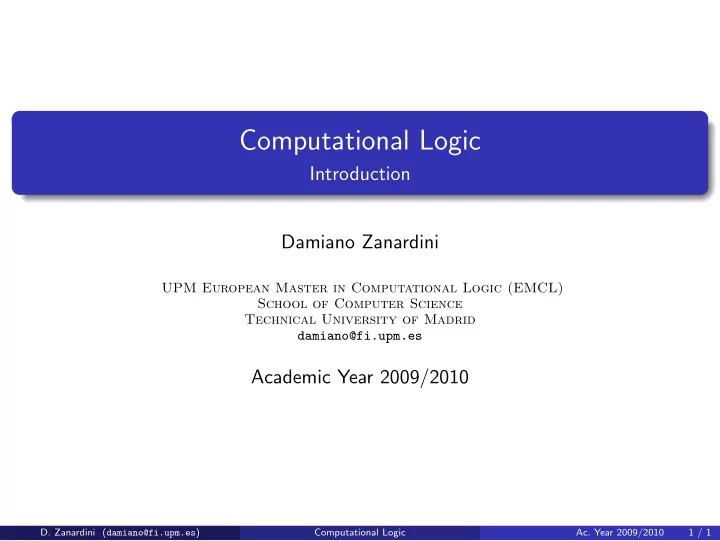

Computational Logic Introduction Damiano Zanardini UPM European Master in Computational Logic (EMCL) School of Computer Science Technical University of Madrid damiano@fi.upm.es Academic Year 2009/2010 D. Zanardini ( damiano@fi.upm.es ) Computational Logic Ac. Year 2009/2010 1 / 1
Presentationp Goal get in touch with the theoretical foundations of Computational Logic (un)satisfiability as a criterion for deduction systematic proof techniques : know and apply study resolution with unification a glance at Automated Theorem Proving (ATP) towards Logic Programming (LP) Formal Logic vs. Computational Logic in theory: FL goes before CL in practice: we are studying both in parallel, so we try to take this into account D. Zanardini ( damiano@fi.upm.es ) Computational Logic Ac. Year 2009/2010 2 / 1
Presentationp How to pass the exam... a written test probably, additional work during the course ☞ it is not enough to attend to classes: this is part of the basic contents of the master, so that you are supposed to really learn and be able to do something Talking to me... ☞ you are strongly invited to come and ask me questions! ☞ you are even more strongly invited to interrupt me during classes any time (Mon → Fri), contact by mail; especially: Tuesday 15.00 → 18.00 Thursday 10.00 → 13.00 mail: damiano@fi.upm.es or damiano.zanardini@gmail.com ☞ please don’t use gmail chat: write a mail instead my office: DIA, N. 2205 (tel. 913366901) D. Zanardini ( damiano@fi.upm.es ) Computational Logic Ac. Year 2009/2010 2 / 1
Contentsp first-order logic: syntax and semantics (recall, see FL course) standardization of formulæ Herbrand universe, Herbrand base, Herbrand interpretations automatic proof techniques theory: semantic trees, Herbrand’s theorem ground methods: Gilmore, Davis-Putnam, Robinson’s resolution resolution with unification resolution strategies extra (1): automated theorem proving implementations applications extra (2): towards logic programming Horn clauses, SLD resolution, logic programs applications D. Zanardini ( damiano@fi.upm.es ) Computational Logic Ac. Year 2009/2010 3 / 1
Referencesp Books, lecture notes and papers C-L. Chang and R.C-T. Lee. Symbolic Logic and Mechanical Theorem Proving . 1973. [FI] J. Cuena. L´ ogica Inform´ atica. Tomo II: L´ ogica Computacional . 1999/2000. (in Spanish; something about program analysis) [FI] J.H. Gallier. Logic for Computer Science: Foundations of Automatic Theorem Proving . 2003. (quite complete) [FI,PDF] M. Huth and M. Ryan. Logic in Computer Science: Modelling and Reasoning about Systems . 2004. (mostly formal logic + program analysis) [FI,PDF] L. de Ledesma. L´ on . 2009. (in Spanish) [FI] ogica para la computaci´ A. Leitsch. The Resolution Calculus . 1997. [E.U. Inform´ atica] L. Paulson. Logic and Proof . 2007. (shorter) [PDF] D. Zanardini ( damiano@fi.upm.es ) Computational Logic Ac. Year 2009/2010 4 / 1
Referencesp Books, lecture notes and papers A. Ramsay. Formal Methods in Artificial Intelligence . 1989 [FI] J.A. Robinson. Computational Logic - Memories of the Past and Challenges for the Future . 2000. (interesting paper) R.M. Smullyan. First-order logic . 1995 (orig. 1968) [FI] T. Tymoczko and J. Henle. Sweet Reason . 1995. (a broader view on logic; definitely good for a read) [FI] Many Authors from UPC. Notas de Clase para IL . 2009. in Spanish, but quite interesting. [I have a copy] D. Zanardini ( damiano@fi.upm.es ) Computational Logic Ac. Year 2009/2010 4 / 1
Links and Resourcesp On the WWW The old webpage (2008/2009) http://clip.dia.fi.upm.es/~damiano/teaching/emcl/cl 08 09/ The new one http://web3.fi.upm.es/AulaVirtual/course/view.php?id=141 password for guest access: lcomp I will put here slides, exercises and any useful stuff about the course D. Zanardini ( damiano@fi.upm.es ) Computational Logic Ac. Year 2009/2010 5 / 1
The core business of Computational Logicp The formal side representing facts in a formal language defining techniques for deducing new facts (theorems) The computational side the same formal machinery, more or less this time, the deduction is automatic (computable) D. Zanardini ( damiano@fi.upm.es ) Computational Logic Ac. Year 2009/2010 6 / 1
The core business of Computational Logicp Mind... ...the difference between proofs as discoveries and proofs as computations ...proof generation vs. proof checking ...the difference between Deep Blue and Garry Kasparov ...the (frustrated) goal of David Hilbert and the formalists ...the happiness you would feel if being told every thing you want to do, I have an automatic tool which gives you the good program for it ! We could say that there is a tradeoff between power : how difficult is what we can do simplicity : how easily (and automatically) we can do things D. Zanardini ( damiano@fi.upm.es ) Computational Logic Ac. Year 2009/2010 6 / 1
The core business of Computational Logicp A machine can be stupid enough to... ...make a useless step Deep Blue: not pruning the tree Apply all the possible legal rules to the current state, which usually amounts to a lot of useless work ...make the least-efficient step In resolution, resolve between two big clauses in the first step Prove F ∧ F without noticing that we can prove F only once (more subtle) Proving F → G starting from proving F ...make one step forward, one backward, one forward, ... F � F ∧ F � F � F ∧ F � F ... ...always make the first step it finds among the legal ones (more tricky) F � F ∧ F � ( F ∧ F ) ∧ ( F ∧ F ) ... Na¨ ıf implementation of simple recursive definitions: (1) Checking ⊆ ; (2) Prolog predicate for Java subclasses Robinson’s example about non-terminating resolution: { p ( a ) , ¬ p ( x ) ∨ p ( f ( x )) } In general, non-termination of depth-first algorithms D. Zanardini ( damiano@fi.upm.es ) Computational Logic Ac. Year 2009/2010 6 / 1
Recommend
More recommend